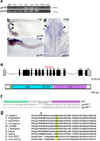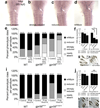The adhesion GPCR Gpr56 regulates oligodendrocyte development via interactions with Gα12/13 and RhoA
- PMID: 25607772
- PMCID: PMC4302765
- DOI: 10.1038/ncomms7122
The adhesion GPCR Gpr56 regulates oligodendrocyte development via interactions with Gα12/13 and RhoA
Abstract
In the vertebrate central nervous system, myelinating oligodendrocytes are postmitotic and derive from proliferative oligodendrocyte precursor cells (OPCs). The molecular mechanisms that govern oligodendrocyte development are incompletely understood, but recent studies implicate the adhesion class of G protein-coupled receptors (aGPCRs) as important regulators of myelination. Here, we use zebrafish and mouse models to dissect the function of the aGPCR Gpr56 in oligodendrocyte development. We show that gpr56 is expressed during early stages of oligodendrocyte development. In addition, we observe a significant reduction of mature oligodendrocyte number and myelinated axons in gpr56 zebrafish mutants. This reduction results from decreased OPC proliferation, rather than increased cell death or altered neural precursor differentiation potential. Finally, we show that these functions are mediated by Gα12/13 proteins and Rho activation. Together, our data establish Gpr56 as a regulator of oligodendrocyte development.
Figures








References
Publication types
MeSH terms
Substances
Grants and funding
LinkOut - more resources
Full Text Sources
Other Literature Sources
Molecular Biology Databases

